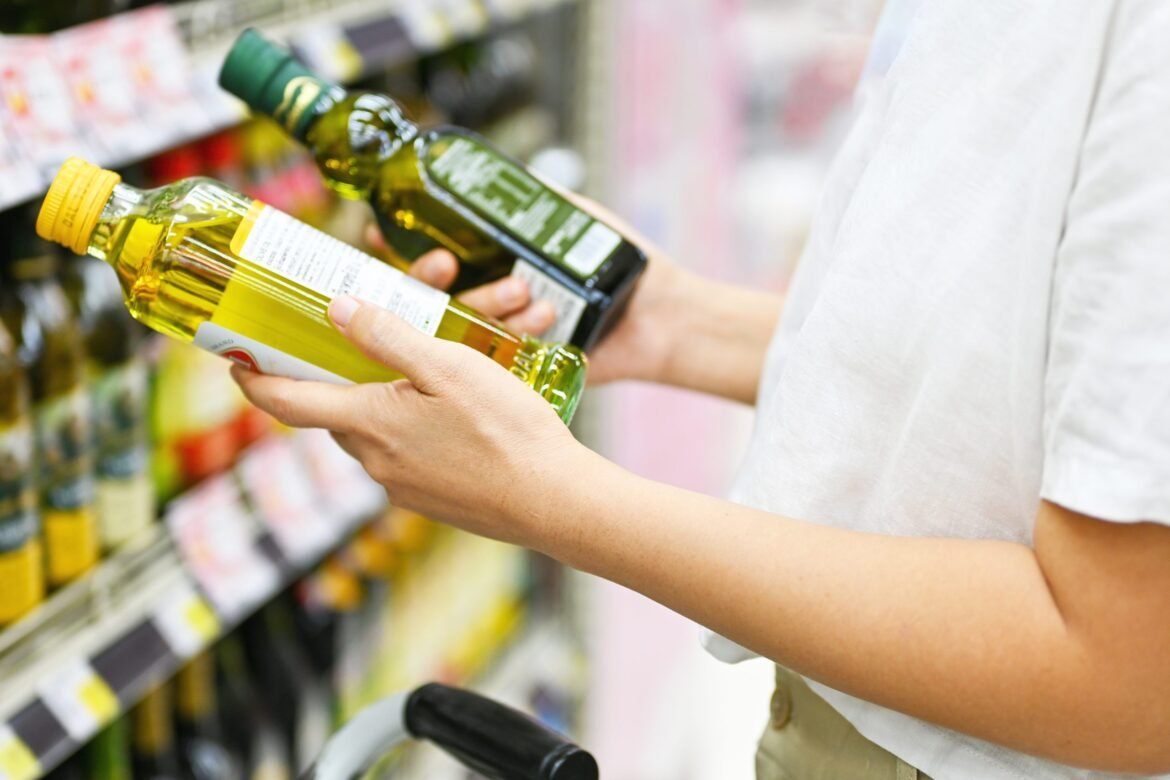Table of Contents
![]()

You wanna know what’s actually making Americans unhealthy right now?
???????? It’s not the f*cking food dyes.
???????? It’s not seed oils.
???????? It’s not “chemicals” in your damn diet ginger ale.
Nope. I spent an entire day this week—as a health and fitness coach—talking to clients who are absolutely paralyzed when it comes to food. These are smart, capable women who are out here crushing it in their careers and lives … and still find themselves stuck in anxiety spirals over eating non-organic frozen vegetables.
They have literally zero clue how they are supposed to eat anymore because it’s mixed messages flying at the every damn day.
This is madness.
I heard things like:
-
“I can’t eat deli meat, it’s toxic.”
-
“I’m afraid of bread—it’s full of chemicals.”
-
“Canned beans are processed. I thought I had to avoid them.”
This is not a coincidence. This is the direct result of a wellness culture that’s turned fear into click-bait content.
I’ve Been There, Too
For the record, I’m not immune. I’ve been down that “clean eating” rabbit hole myself.
In my own obsessive pursuit of “optimal health,” I spent years eliminating anything “processed,” avoiding “toxins,” and focusing only on nutrient-dense whole foods. Sounds healthy, right?
Except I was training hard and undereating for a long-ass time thanks to all the food rules I made up for myself in the name of “being healthy”.
That restrictive mindset wrecked my energy, disrupted my hormones, and left me battling symptoms of low energy availability (LEA)—including stress fractures, brain fog, anxiety, fatigue, sleep disruptions, and recovery issues.
And in order to heal, I had to let go of all the restrictive food rules and fear of “toxic” foods so I could just f*cking eat food. My mental health was also much better as a result since I was no longer stressing over single food ingredients and was focusing more on the things that actually matter and move the needle when it comes to health and wellbeing (sit tight, more on those below).
And I see the same patterns playing out in so many of the women I coach today.
Not because they don’t care about their health—because they care a lot and have been taught to focus on the wrong damn things.
Enter: The Wellness Influencer Circus ????
Here’s the playbook: influencers walk through their local grocery store with their ring light and a smug half-smirk, pick up a normal food item that the average family might buy, flip over the label, and gasp dramatically while declaring in their most judgmental tone:
❌ “This has seed oils—it’s inflammatory!”
❌ “You can’t pronounce that ingredient—it’s toxic!”
❌ “If it has more than three ingredients, it’s not real food!”
And of course, they always have a better alternative—conveniently linked to a brand they’re partnering with … and receiving a commission from. Or head to their website and you’ll find they sell their own products that will make your weekly grocery bill look more like a luxury car payment.
Spoiler alert: if you actually tried to eat the way these folks recommend, you’d spend your entire paycheck and a shit ton of anxiety on finding foods with only organic ingredients … and likely develop disordered eating habits along the way. Meanwhile, they’re cashing checks by selling fear and virtue signaling disguised as “wellness.”
Let’s call it what it is: a scam.
“Clean Eating” Is Made Up
There is no scientific definition for “clean eating.” There is no universal standard for what’s “clean,” “dirty,” “good,” or “toxic.” And yet, the number of women I see developing disordered eating patterns is skyrocketing—largely fueled by influencers who confuse food literacy with fearmongering.
Let’s be very clear:
???? The dose makes the poison.
This is Toxicology 101.
According to Dr. Andrea Love, “ Toxicity refers to a chemical, physical, or biological exposure that might cause harm to an organism, either directly or indirectly. Scientifically, anything can be toxic at a certain exposure. Anything can be non-toxic at a certain [different] exposure.”
She goes on to further explain “It’s about exposure — how much of a substance, how often, and how it enters the body. All of these elements are needed to determine if something is toxic.”
The examples she provides are great to illustrate this point. For example, drinking too much water in a short period of time can kill you. And that’s not the only way water – which makes up 60% of your body – can kill you. If just a small amount of water goes down the wrong pipe into your lungs rather than into your stomach, you can die.
There are plenty of examples that also go the other way—substances that kill humans when administered in the right dose but also are essential for life in small quantities or are used in medications to save lives.
The idea that an ingredient is automatically “toxic” just because it has a long name or was tested in absurd doses on rats is nonsense.
So no, you’re not slowly killing your kids with a granola bar. And yes, you can eat a sandwich without fear of “carcinogens.”
What I Focus On Instead
I don’t spend time worrying about nitrates in my turkey slices, the food dye in my gummy bears, or the “processed” nature of my favorite protein bar.
Because I’m too busy helping women:
✅ Get enough fruits, veggies, and fiber to support health
✅ Eat enough protein to support muscle and aging
✅ Fuel their bodies with enough calories to power their lives
✅ Meet the Physical Activity Guidelines with strength training and cardio
Because these are things that truly matter is we want to help people get healthier. And there is a large body of evidence that is very clear which support that each of these things is foundational to overall health and being.
The women I coach aren’t struggling because of the chemicals in their almond milk. They’re struggling because they’re trying to navigate a world where doing the things they need to do to be a healthy is difficult and nutrition advice is driven by clicks, not care.
And once they’ve developed sustainable strategies for getting the four pillars above in place, they are well on their way to being healthy—no obsessing over individual ingredients required.
MAHA Is the New Diet Culture
Let’s not mince words: this is just diet culture 2.0.
The Make America Healthy Again (MAHA) movement is diet culture wrapped in a wellness hoodie. It demonizes ingredients, moralizes food choices, and shames people for not living up to an impossible standard of purity. All trademarks of diet culture.
Even worse? It distracts us from the real public health crises:
-
Food insecurity
-
Lack of nutrition education
-
Inaccessible, unaffordable healthcare
-
Corporate policies that prioritize profits over people
All of these things make it difficult, if not damn-near impossible, for many Americans to meet the dietary and physical activity guidelines that (as I mentioned above) are the true foundations of health and wellness.
Dr. Jessica Knurick calls MAHA what it is: a deliberate distraction to keep us from demanding systemic change. Because screaming about “chemicals” and “toxins” in our food without any actual scientific evidence of harm is easier than dealing with underlying widespread, systemic issues. And it would require us to care about people who are less privileged than ourselves and that, sadly, appears to be a bridge too far for many who argue for MAHA.
And while it may feel easier to focus on food dyes and seed oils, it’s not meaningful change that’s supported by science. There is no evidence to suggest that banning these ingredients will improve the health of anyone. Therefore, I suspect (and many experts agree) that it will be a massive waste of taxpayer dollars and exponentially increase the weekly grocery bill for all Americans to go down this road without first addressing the underlying systemic issues first.
And Let’s Talk About Big Wellness for a Sec
It’s wild how many people will scream about “Big Pharma” while buying unregulated supplements from an Instagram ad with zero skepticism.
Yes, Big Pharma deserves scrutiny—but at least it’s required to submit peer-reviewed studies and undergo regulatory approval.
Big Wellness? It’s a $6.3 trillion industry (4 times the size of Big Pharma) with almost no oversight.
And many of its loudest voices are creating monetized misinformation by:
-
Cherry-picking junk science to back their biases
-
Pushing elitist food standards that are inaccessible to most people
-
Selling green powders, detoxes, and supplements to “fix” problems they invented
-
Preying on our desire to do the “right” thing for our health
-
Undermining trust in science and medicine to boost their own authority (and bank account)
Here’s the Truth:
If your food rules are so restrictive that they’re preventing you from eating enough, nourishing your body, or enjoying your life—it’s time for a reality check.
I see women over and over again trying to adhere to a bunch made-up food rules they picked up from fear-based food influencers with no real evidence to support them only to obsess over them to the point that it’s all they can think about … until the cravings win and they eat a whole package of the food they were trying to avoid because some unqualified weirdo on the internet told them it was toxic.
You deserve better than fear-based nutrition advice. You deserve science, context, and nuance.
There is a big, beautiful middle ground where processed foods can fit, where you don’t have to choose between “organic kale” or “cancer,” and where joy, satisfaction, and nourishment can all live on the same plate.
Want Evidence-Based Nutrition Info from People Who Know Their Shit?
Follow these experts:
And if you’re ready to learn how to train and fuel in a way that’s free from wellness influencer B.S. and fear, come hang with me in LIMITLESS. I’ll teach you how to train, eat, and live in a way that actually supports your long-term health and strength—no food anxiety or ingredient obsession required. —Alison


